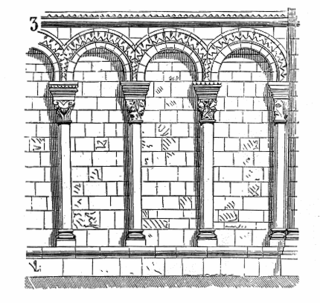Top Qs
Timeline
Chat
Perspective
Blind arcade
Architectural element From Wikipedia, the free encyclopedia
Remove ads
A blind arcade, also called a blank arcade,[1] is an arcade (a series of arches) that lacks actual openings and is applied to the surface of a wall as a decorative element; that is, the arches are not openings, but form part of the masonry façade. It is designed as an ornamental architectural element, without any load-bearing function.

Similar structures
Whereas a blind arch is usually a single arch or a series of joined arches as a frieze (sometimes called Lombard band), a blind arcade is composed of a series of arches that have well-defined columns in between its arches.
A blind arcade may resemble several blind windows (false/blank windows or sealed-up windows)[1] or blind niches that are side by side.
Examples
Blind arcades are a common decorative features on the facades of Romanesque and Gothic buildings throughout Western Europe, and are also a common feature in Byzantine Orthodox churches in Eastern Europe, and in Armenian churches.
- Córdoba, Spain
- Norwich Cathedral, Norfolk, United Kingdom
- Canterbury Cathedral, England (interlaced arches)
- Linköping Cathedral, Sweden
- Great Mosque of Kairouan (Mosque of Uqba), Tunisia
- Blind arcade on Ardmore Cathedral, Ireland, with sculpted Biblical scenes (12th century)
Remove ads
See also
Wikimedia Commons has media related to Blind arcades.
References
External links
Wikiwand - on
Seamless Wikipedia browsing. On steroids.
Remove ads













